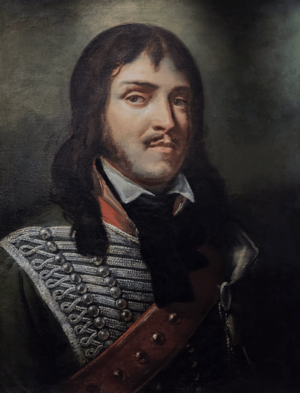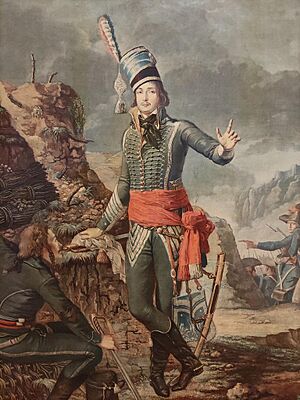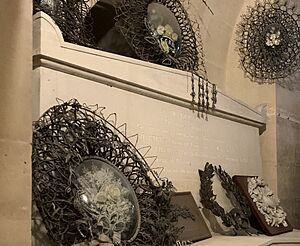François Séverin Marceau facts for kids
Quick facts for kids
François Séverin Marceau
|
|
|---|---|

General Marceau, by François Bouchot, Musée de l'armée
|
|
| Born | 1 March 1769 Chartres, Kingdom of France |
| Died | 19 September 1796 (aged 27) Altenkirchen, Holy Roman Empire |
| Buried | |
| Allegiance | |
| Years of service | 1785–96 |
| Rank | Divisional general |
| Commands held | Armée de l'Ouest Fortress of Mainz |
| Battles/wars | French Revolutionary Wars |
| Awards | Names inscribed under the Arc de Triomphe |
| Other work | Minister of War |
François Séverin Marceau-Desgraviers (born March 1, 1769 – died September 21, 1796) was a brave French general. He fought during the French Revolutionary Wars, a big conflict in France. He is remembered for his courage and leadership.
Contents
Becoming a Soldier
Marceau was born in Chartres, France, on March 1, 1769. His father was a lawyer. When he was 16, in December 1785, Marceau joined the army. He was part of the Angoulême Infantry Regiment. This regiment later became the 34th Infantry Regiment.
While on leave in Paris, Marceau took part in a very important event. This was the storming of the Bastille on July 14, 1789. This event helped start the French Revolution. After this, he left the regular army. He went back to Chartres. But his family wanted him to keep serving in the military. So, he looked for new army work.
Fighting for the Revolution
In July 1792, Marceau became a captain in the French Revolutionary Army. He led the 2nd Battalion of Volunteers from Eure-et-Loir. He helped defend Verdun later that year. His group was chosen to deliver the surrender terms to the Prussian army.
The soldiers defending Verdun had low spirits. This made the revolutionary leaders angry. Luckily, Marceau found a new job as a captain in the regular army. However, in early 1793, he was arrested. He was held in prison for a short time, like other officers who were suspected of not being loyal enough.
Battles in the Vendée Region
After being released, Marceau quickly joined the fight. He helped defend Saumur against the Royalists. These were people who supported the king during the War in the Vendée. Marceau showed great bravery at the Battle of Saumur on June 10, 1793. He saved a leader named Pierre Bourbotte from the rebels.
Because of his bravery, the National Convention thanked him. He was quickly promoted. His actions at the Battle of Chantonnay on September 5, 1793, made him a temporary general of brigade. On October 17, he played a big part in the victory at the Second Battle of Cholet. Here, he became good friends with Jean Baptiste Kléber.
Kléber became a general of division. Marceau's rank as general of brigade was made permanent. Then, Marceau became a general of division himself on November 10. He also took over as temporary commander-in-chief. With Kléber, he defeated the Vendée rebels. This happened at the Battle of Le Mans on December 12–13, and at the Battle of Savenay on December 23, 1793.
After the Battle of Le Mans, Marceau helped a young Royalist lady named Angélique des Mesliers. He tried to protect her.
Later Campaigns (1795–1796)
After spending the winter of 1793–1794 in Paris, Marceau took a new command. He joined the army under Jean-Baptiste Jourdan, fighting alongside Kléber. He took part in many battles near Charleroi. During the Battle of Fleurus on June 26, 1794, his horse was shot from under him. He also showed great skill at Jülich, Aldenhoven, and Koblenz. In Koblenz, he attacked enemy lines on October 23.
He also fought in the campaigns of 1795 and 1796. He was with the armies of the Sambre and Meuse rivers. He fought near the Rhine and Lahn rivers. He stood out alongside Kléber and Charles XIV John (Jean-Baptiste Bernadotte). Bernadotte later became king of Sweden. They fought well together near Neuwied and Sulzbach. Marceau and Bernadotte became close friends. They often worked together and won many battles.
His Final Days
The Rhine Campaign of 1796 led by Jourdan and Jean Victor Marie Moreau ended in defeat. Marceau's soldiers helped cover Jourdan's retreat across the Rhine River. Marceau fought bravely in the difficult Battle of Limburg on the Lahn River. This battle lasted from September 16 to 19, 1796.
While leading a successful rear guard action near Altenkirchen on September 19, he was badly wounded. He died two days later, in the early morning. He was only twenty-seven years old.
Even the Austrians, who were his enemies, honored the fallen general. His body was cremated. His ashes were placed under a pyramid in Koblenz. This pyramid was designed by his friend Kléber. In 1889, his ashes were moved to the Panthéon in Paris. This is a special place where many French heroes are buried.
Lord Byron, a famous poet, wrote about Marceau in his poem Childe Harold's Pilgrimage:
- LVI
- By Coblentz, on a rise of gentle ground,
- There is a small and simple pyramid,
- Crowning the summit of the verdant mound;
- Beneath its base are heroes' ashes hid,
- Our enemy's – but let not that forbid
- Honour to Marceau! o'er whose early tomb
- Tears, big tears, gush'd from the rough soldier's lid,
- Lamenting and yet envying such a doom,
- Falling for France, whose rights he battled to resume.
- LVII
- Brief, brave, and glorious was his young career, —
- His mourners were two hosts, his friends and foes;
- And fitly may the stranger lingering here
- Pray for his gallant spirit's bright repose;
- For he was Freedom's champion, one of those,
- The few in number, who had not o'erstept
- The charter to chastise which she bestows
- On such as wield her weapons; he had kept
- The whiteness of his soul, and thus men o'er him wept.




